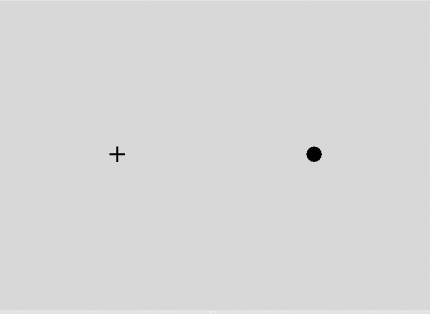Hack #16. Map Your Blind Spot
Find out how big your visual blind spot is and how your brain fills the hole so you don’t notice it.
Coating the back of each eye are photoreceptors that catch light and convert it to nerve impulses to send to the brain. This surface, the retina, isn’t evenly spread with receptors—they’re densest at the center and sparse in peripheral vision [[Hack #14]]. There’s also a patch that is completely devoid of receptors; light that falls here isn’t converted into nerve signals at all, leaving a blind spot in your field of view—or actually two blind spots, one for each eye.
In Action
First, here’s how to notice your blind spot (later we’ll draw a map to see how big it is). Close your left eye and look straight at the cross in Figure 2-6. Now hold the book flat about 10 inches from your face and slowly move it towards you. At about 6 inches, the black circle on the right of the cross will disappear, and where it was will just appear grey, the same color as the page around it.

Figure 2-6. A typical blind spot pattern
You may need to move the book back and forth a little. Try to notice when the black circle reappears as you increase the distance, then move the book closer again to hide the circle totally. It’s important you keep your right eye fixed on the cross, as the blind spot is at a fixed position from the center of vision and you need to keep it still to find ...
Get Mind Hacks now with the O’Reilly learning platform.
O’Reilly members experience books, live events, courses curated by job role, and more from O’Reilly and nearly 200 top publishers.

